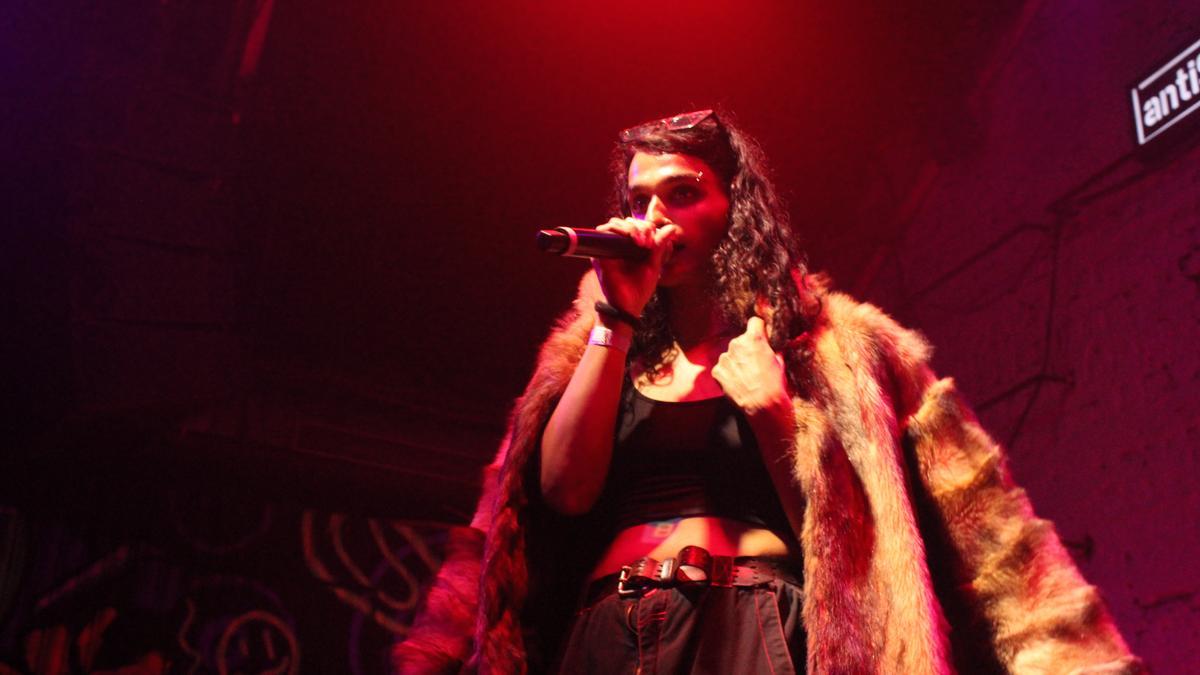
For decades, the portrayal of marginalized communities in art and media has swung between extremes, presenting them as either saintly or sinful. This simplistic dichotomy has often exacerbated the struggle for nuanced representation. However, in the past five years, the narrative surrounding queer subjects has become more layered, largely thanks to queer individuals who have taken control of how their stories are told. Trans rappers Kinari and Shehzor exemplify this shift with their groundbreaking albums released earlier this year: Kinari’s “Kattar Kinnar” and Shehzor’s “The Girl with Sideburns”. These albums serve as powerful arguments for the value of authentic representation, moving beyond tokenism to offer genuinely complex and richly textured portrayals of their lived experiences.
“The queer art and media around me were channelling happiness and pride,” Kinari, a Chennai-born, Delhi-based trans woman rapper, producer, and DJ, explained during a late-night phone call. “But for me, this isn’t the entire truth. The on-ground reality of being a trans woman in this country isn’t all sunshine and rainbows.” Her debut album, “Kattar Kinnar,” seeks to capture this complicated reality. It’s a compositionally lush work, its lyrical brilliance enriched with references that speak directly to India’s queer pop culture and camp histories.
“Kattar Kinnar” features musical and film dialogue samples that resonate deeply with Kinari. For example, snippets from the 1988 Rekha-starrer “Khoon Bhari Maang” are interspersed throughout the album. “This film was very inspiring for me because it introduced me to cosmetic surgery for the first time. I identified with Rekha’s character, a woman wronged by society. I feel it is a very trans film,” she said. “The music cues and sound effects in the film were ‘kattar’ [dangerous], and that was the mood of my album, too.”
Hyderabad-born and based rapper-producer Shehzor offers a different, albeit equally compelling, perspective in her debut album “The Girl with Sideburns.” Created during six months spent back with her birth family, the album is a fusion of memories and the mundane, reflective of Shehzor’s unique creative process. “I began to play around and make beats on my laptop and watch Bollywood films to snip samples from them,” she recounted. “I then played these self-produced tracks and ‘freestyled the lyrics’ to myself while riding my mother’s Scooty through the city, before recording them.
. This is how I developed each of the 11 tracks on my album.”
Shehzor’s work differs not just in production but also in linguistic style. She performs in Hyderabadi dakhini, a dialect spoken across parts of Telangana, Andhra Pradesh, Karnataka, and Maharashtra. “I saw Hyderabadi rappers using this language mainly for crowd-work or banter, but not for rapping,” she said. “They’ve internalized the idea that one can’t be serious in dakhini. For me, using this dialect rich with humor, playfulness, and even vulgarity, allowed fresher ways of narrating the serious poetry of my queer identity and gender journey.”
Both “Kattar Kinnar” and “The Girl with Sideburns” defy stereotypes, sidestepping the often limited roles of victim or saint imposed on marginalized people. Instead, both Kinari and Shehzor offer trenchant critiques of their communities and broader society. Kinari’s album combines the influences of Delhi’s Khirki Extension, Bollywood beats, and Tamil musicality, wielded deftly through parai drum beats and gaan-inspired soundscapes. She’s unflinchingly defiant and braggadocious, addressing topics from relationships to societal double-standards: “Your man’s safe only cause he’s ugly”; “Mai boli baby jhukne ki zarurat nahi/5 inch heels pe main kaafi tall” (Let me tell you baby, there’s no need to bow down/I look down on you in my 5-inch heels).
On the other hand, Shehzor’s style leans more towards intricate storytelling, blending her personal narratives with mythological and religious elements. In the track “Waat”, for instance, she revisits the story of prophet Ayyub, akin to Job from the Bible. The track reflects her playful take on the fable and critiques the notion of ‘sabr’ or patience as divine tests: “Sabr ka phal aaya toh zubaan jal gaayi” (by the time the sweet fruit of patience arrived, my tongue was already on fire).
Looking ahead, both artists refuse to be pigeonholed. Shehzor plans to continue working in Hyderabadi dakhini but is also moving to Goa to start a rock band with friends. She intends to pop up in various cities to perform tracks from her album in an “unplanned, impromptu mini tour”. Kinari, on the other hand, is addressing new themes in her upcoming project “Pinjre Ke Geet”. With tracks like “Bhakt” and “Khvab”, she is steering towards more melodic meditations, inviting listeners to look beyond her brash persona to appreciate her vulnerability.
These artists are not just creating music; they’re shaping narratives, challenging preconceived notions, and offering a potent mix of reality and artistry that redefines representation. Their work is a testament to the power of owning one’s story, reshaping the discourse around queer identities in ways that are authentic, engrossing, and undeniably impactful.












